OPS935 Project Management Report: Critical Path, Risks, and Tasks
VerifiedAdded on 2022/07/28
|8
|971
|30
Report
AI Summary
This project management report presents a comprehensive analysis of project planning and execution. The report identifies the critical path activities within a project, providing a clear understanding of the essential tasks and their dependencies. It also addresses common problems encountered in Gantt charts, such as the lack of Work Breakdown Structure (WBS) IDs, resource assignments, and cost estimations, offering practical solutions to enhance clarity and effectiveness. Furthermore, the report proposes five new tasks aimed at avoiding the cost of non-conformance, emphasizing the importance of quality planning, scheduling, and resource allocation. Additionally, it identifies potential risks within the project, detailing mitigation and contingency plans to address issues like task dependencies, resource allocation, and milestone management. The report includes references to support the analysis and recommendations, providing a well-structured and insightful overview of project management principles and practices.
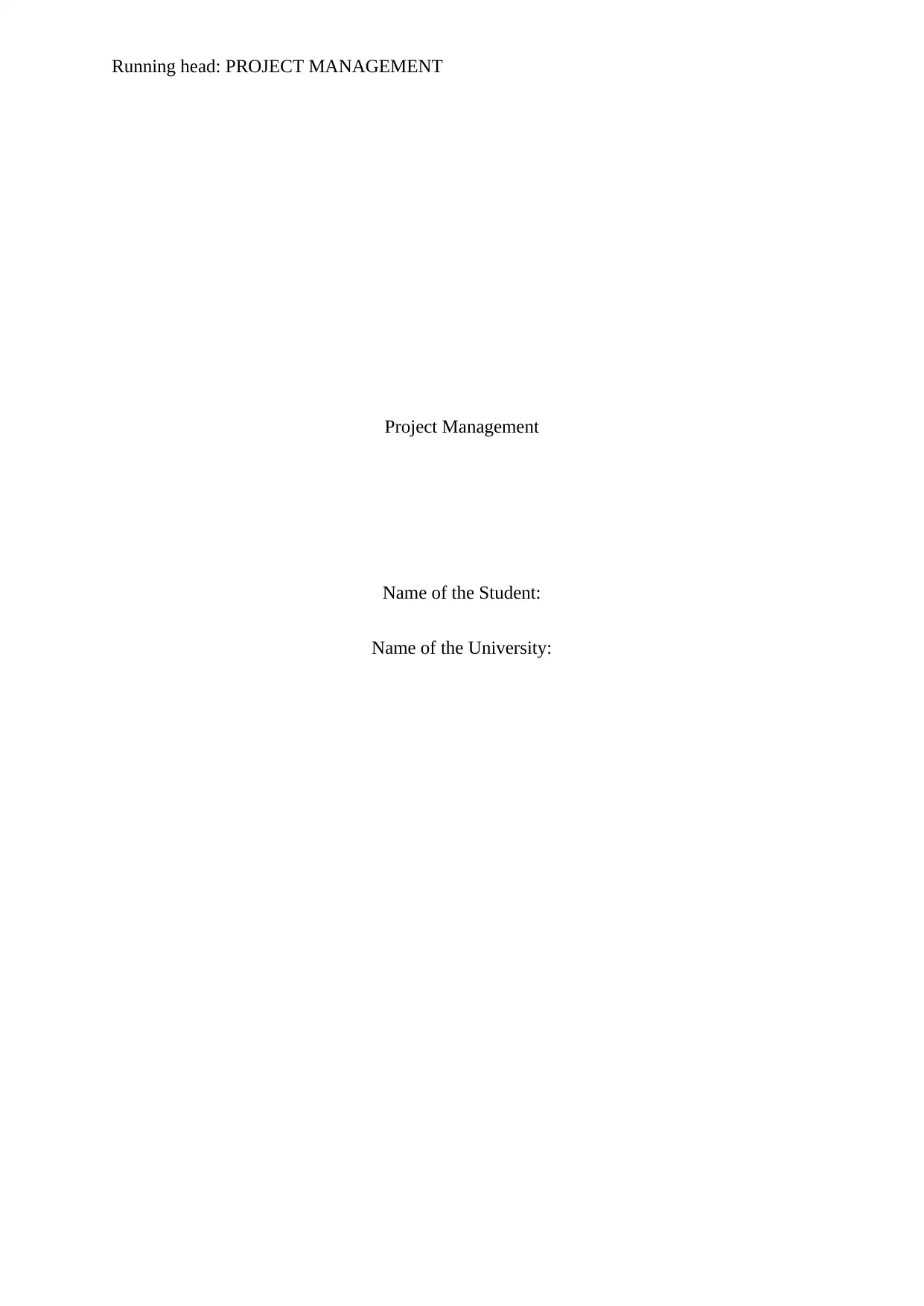
Running head: PROJECT MANAGEMENT
Project Management
Name of the Student:
Name of the University:
Project Management
Name of the Student:
Name of the University:
Paraphrase This Document
Need a fresh take? Get an instant paraphrase of this document with our AI Paraphraser
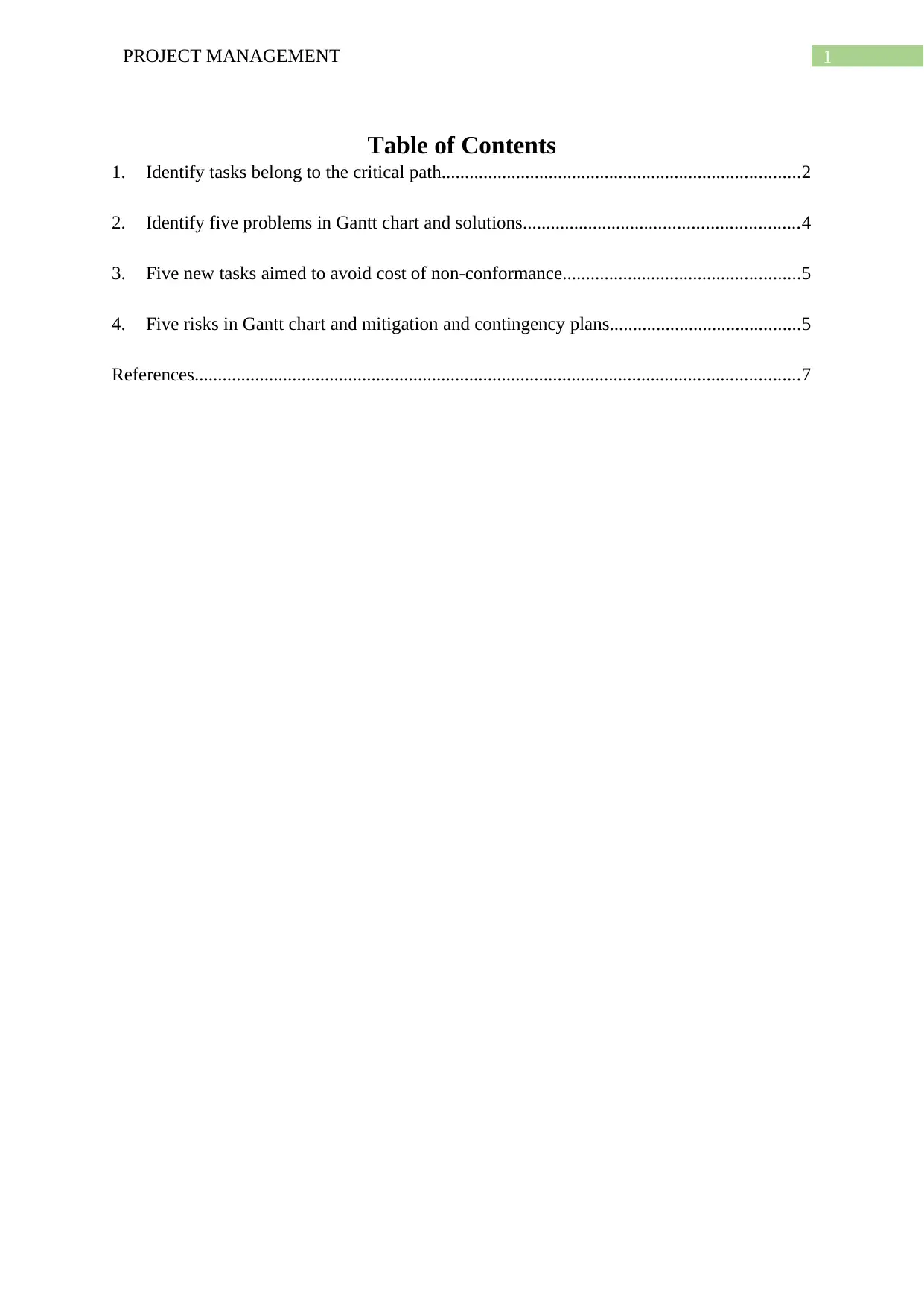
1PROJECT MANAGEMENT
Table of Contents
1. Identify tasks belong to the critical path.............................................................................2
2. Identify five problems in Gantt chart and solutions...........................................................4
3. Five new tasks aimed to avoid cost of non-conformance...................................................5
4. Five risks in Gantt chart and mitigation and contingency plans.........................................5
References..................................................................................................................................7
Table of Contents
1. Identify tasks belong to the critical path.............................................................................2
2. Identify five problems in Gantt chart and solutions...........................................................4
3. Five new tasks aimed to avoid cost of non-conformance...................................................5
4. Five risks in Gantt chart and mitigation and contingency plans.........................................5
References..................................................................................................................................7
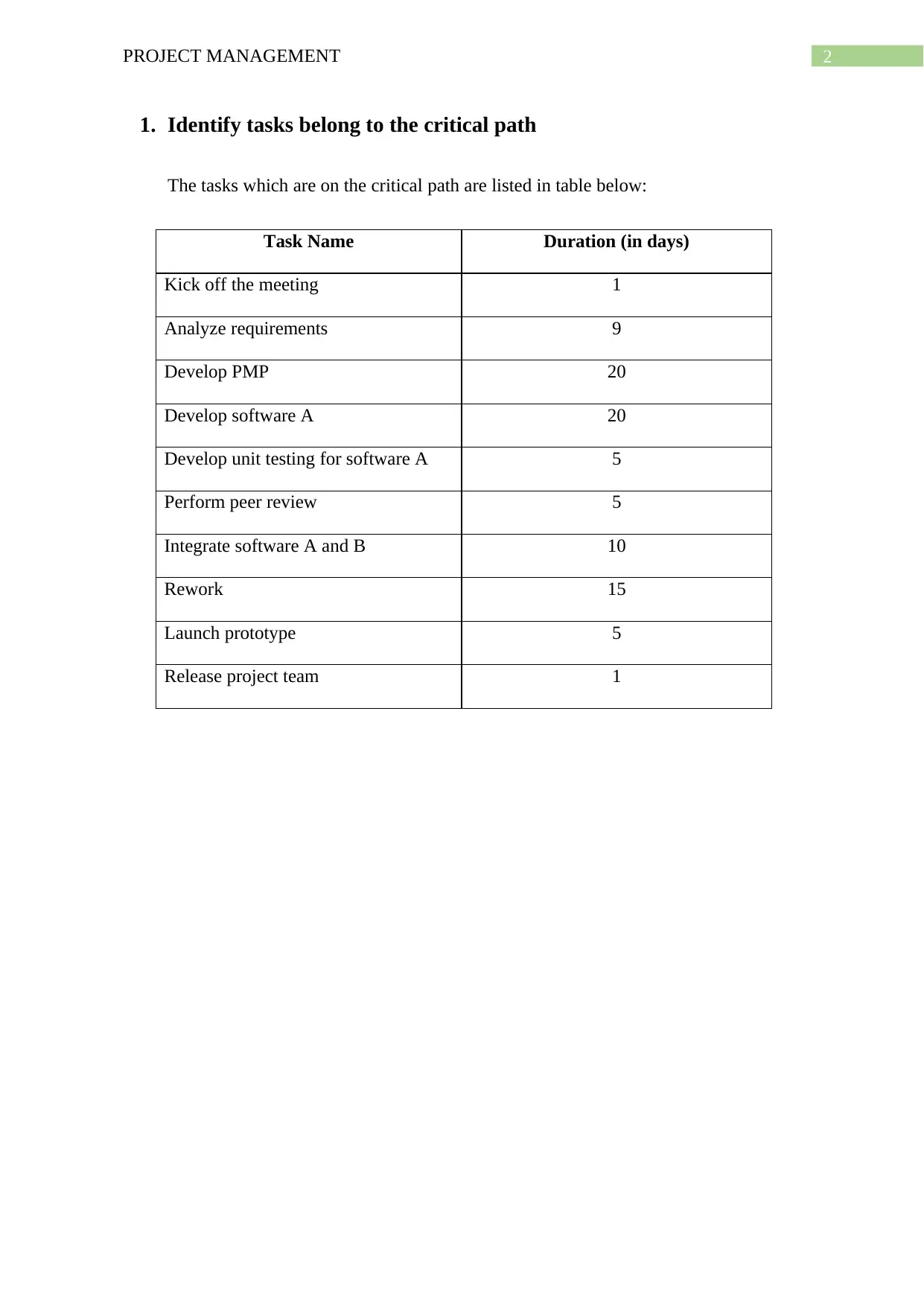
2PROJECT MANAGEMENT
1. Identify tasks belong to the critical path
The tasks which are on the critical path are listed in table below:
Task Name Duration (in days)
Kick off the meeting 1
Analyze requirements 9
Develop PMP 20
Develop software A 20
Develop unit testing for software A 5
Perform peer review 5
Integrate software A and B 10
Rework 15
Launch prototype 5
Release project team 1
1. Identify tasks belong to the critical path
The tasks which are on the critical path are listed in table below:
Task Name Duration (in days)
Kick off the meeting 1
Analyze requirements 9
Develop PMP 20
Develop software A 20
Develop unit testing for software A 5
Perform peer review 5
Integrate software A and B 10
Rework 15
Launch prototype 5
Release project team 1
⊘ This is a preview!⊘
Do you want full access?
Subscribe today to unlock all pages.

Trusted by 1+ million students worldwide
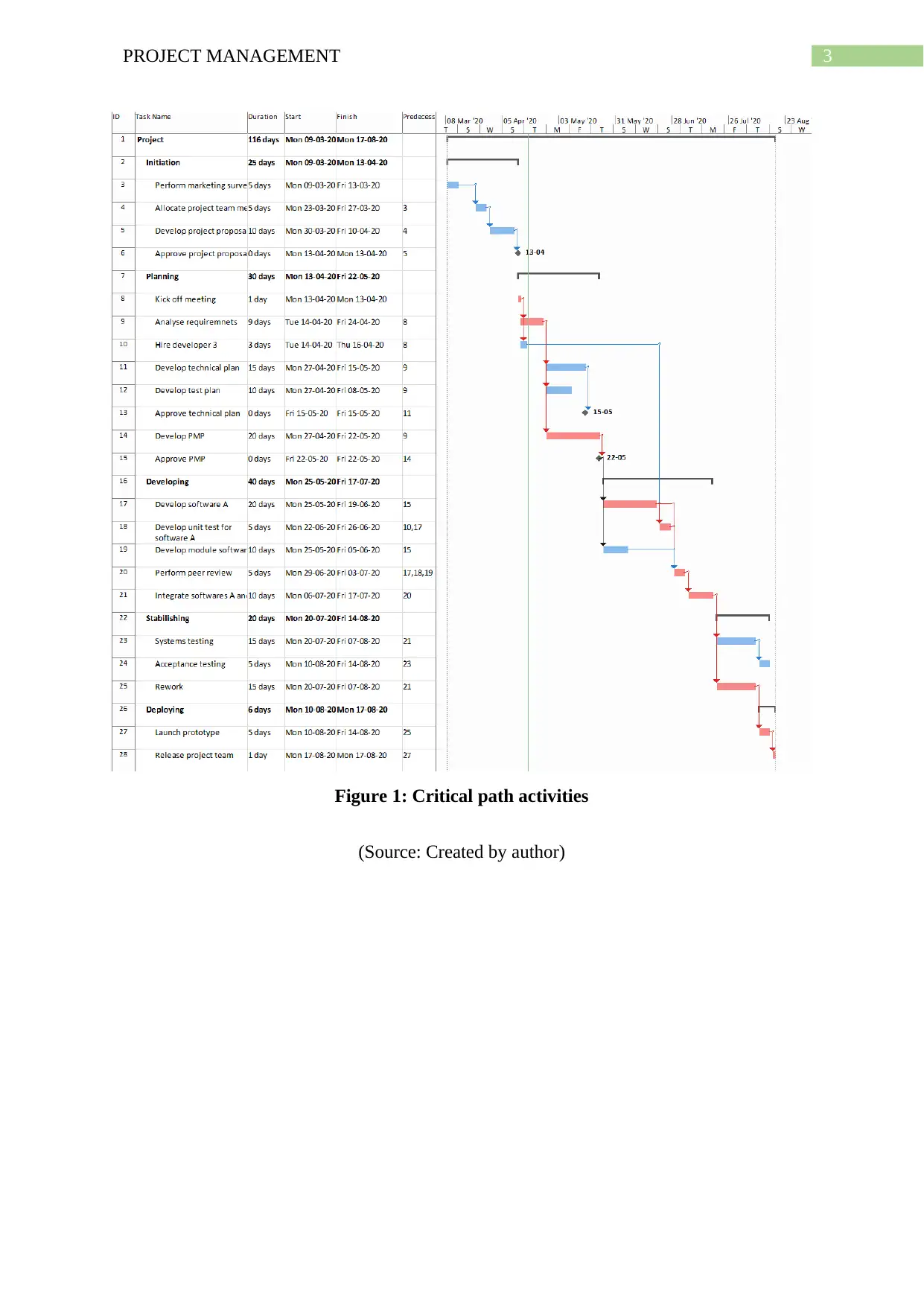
3PROJECT MANAGEMENT
Figure 1: Critical path activities
(Source: Created by author)
Figure 1: Critical path activities
(Source: Created by author)
Paraphrase This Document
Need a fresh take? Get an instant paraphrase of this document with our AI Paraphraser
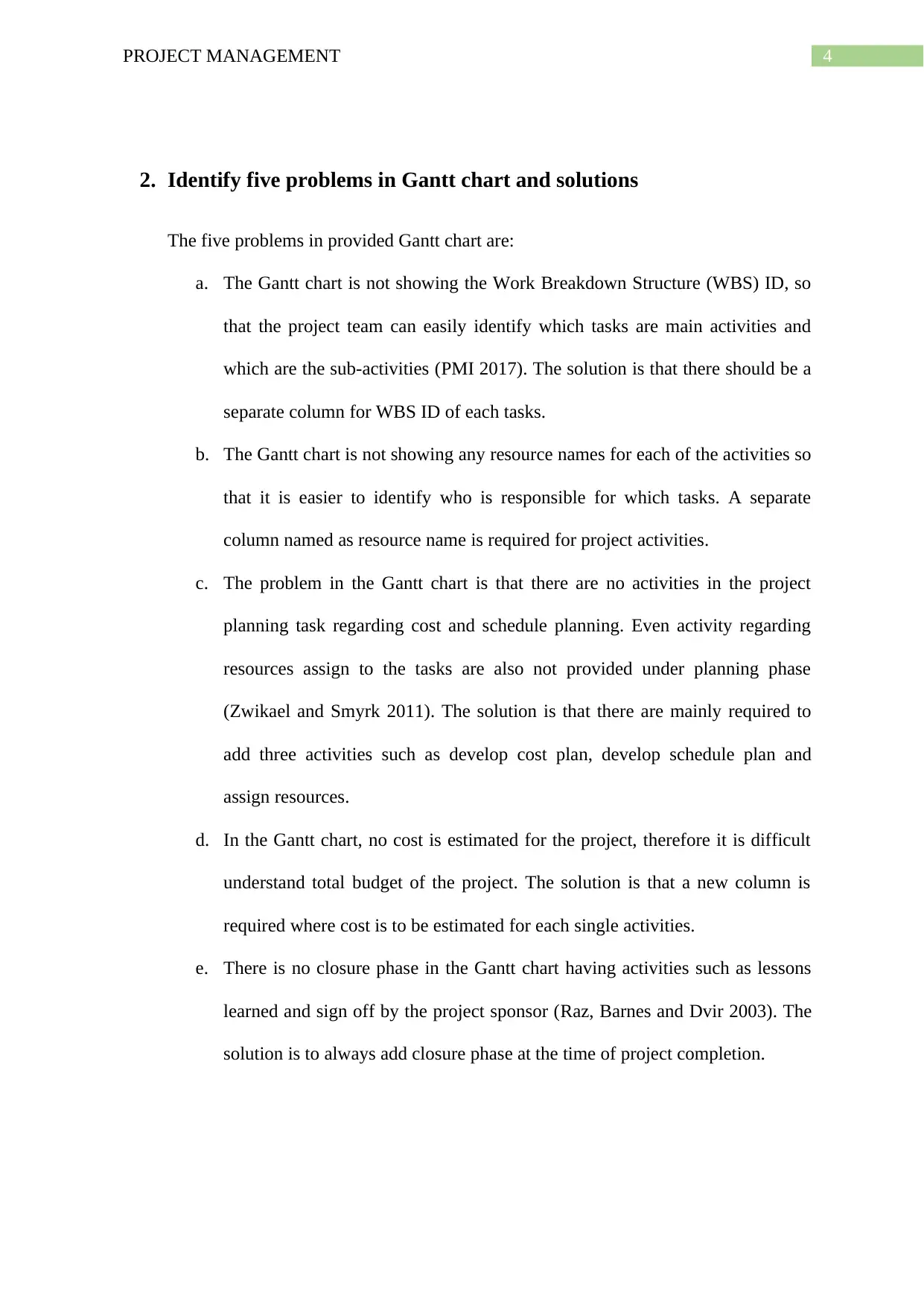
4PROJECT MANAGEMENT
2. Identify five problems in Gantt chart and solutions
The five problems in provided Gantt chart are:
a. The Gantt chart is not showing the Work Breakdown Structure (WBS) ID, so
that the project team can easily identify which tasks are main activities and
which are the sub-activities (PMI 2017). The solution is that there should be a
separate column for WBS ID of each tasks.
b. The Gantt chart is not showing any resource names for each of the activities so
that it is easier to identify who is responsible for which tasks. A separate
column named as resource name is required for project activities.
c. The problem in the Gantt chart is that there are no activities in the project
planning task regarding cost and schedule planning. Even activity regarding
resources assign to the tasks are also not provided under planning phase
(Zwikael and Smyrk 2011). The solution is that there are mainly required to
add three activities such as develop cost plan, develop schedule plan and
assign resources.
d. In the Gantt chart, no cost is estimated for the project, therefore it is difficult
understand total budget of the project. The solution is that a new column is
required where cost is to be estimated for each single activities.
e. There is no closure phase in the Gantt chart having activities such as lessons
learned and sign off by the project sponsor (Raz, Barnes and Dvir 2003). The
solution is to always add closure phase at the time of project completion.
2. Identify five problems in Gantt chart and solutions
The five problems in provided Gantt chart are:
a. The Gantt chart is not showing the Work Breakdown Structure (WBS) ID, so
that the project team can easily identify which tasks are main activities and
which are the sub-activities (PMI 2017). The solution is that there should be a
separate column for WBS ID of each tasks.
b. The Gantt chart is not showing any resource names for each of the activities so
that it is easier to identify who is responsible for which tasks. A separate
column named as resource name is required for project activities.
c. The problem in the Gantt chart is that there are no activities in the project
planning task regarding cost and schedule planning. Even activity regarding
resources assign to the tasks are also not provided under planning phase
(Zwikael and Smyrk 2011). The solution is that there are mainly required to
add three activities such as develop cost plan, develop schedule plan and
assign resources.
d. In the Gantt chart, no cost is estimated for the project, therefore it is difficult
understand total budget of the project. The solution is that a new column is
required where cost is to be estimated for each single activities.
e. There is no closure phase in the Gantt chart having activities such as lessons
learned and sign off by the project sponsor (Raz, Barnes and Dvir 2003). The
solution is to always add closure phase at the time of project completion.
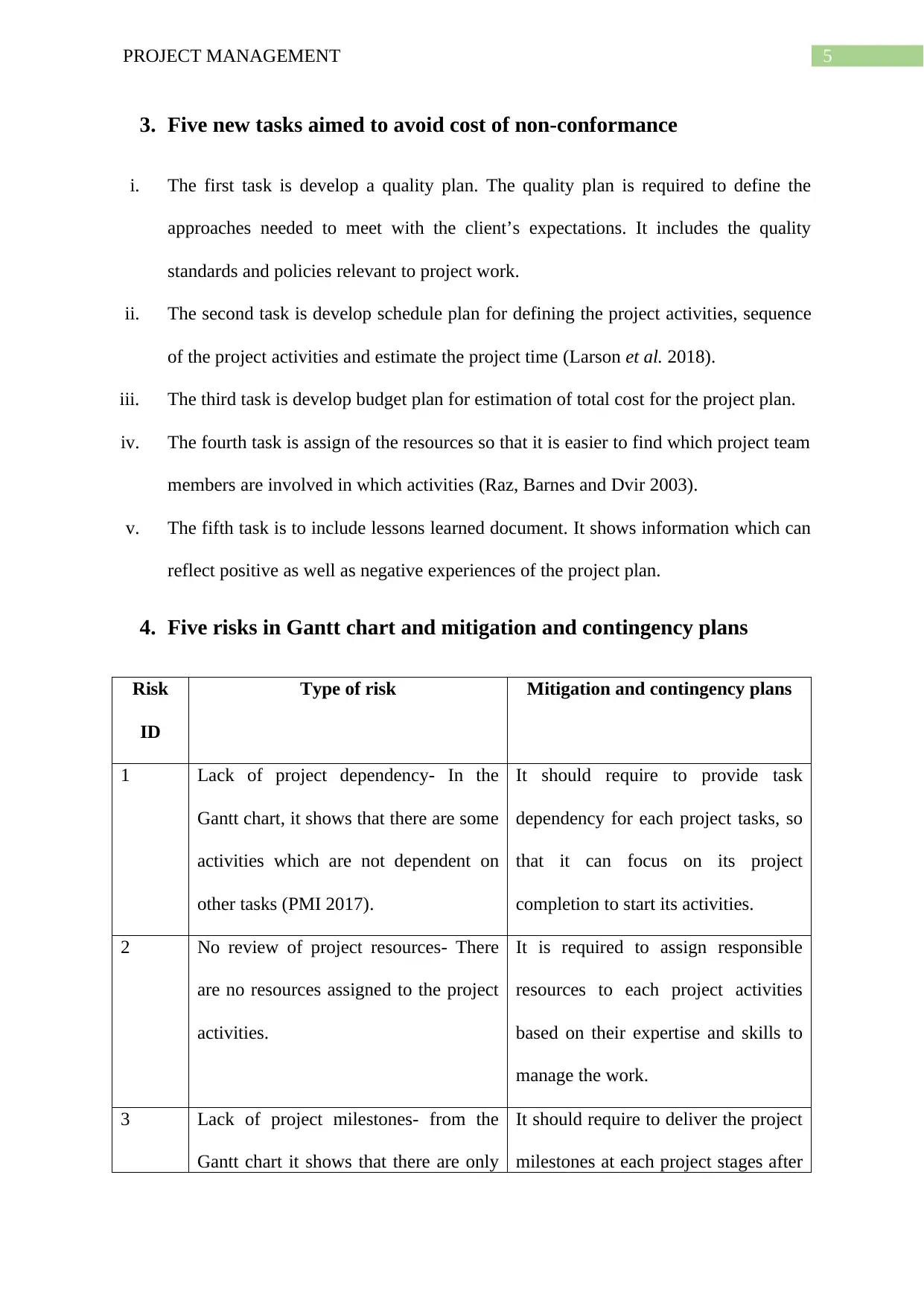
5PROJECT MANAGEMENT
3. Five new tasks aimed to avoid cost of non-conformance
i. The first task is develop a quality plan. The quality plan is required to define the
approaches needed to meet with the client’s expectations. It includes the quality
standards and policies relevant to project work.
ii. The second task is develop schedule plan for defining the project activities, sequence
of the project activities and estimate the project time (Larson et al. 2018).
iii. The third task is develop budget plan for estimation of total cost for the project plan.
iv. The fourth task is assign of the resources so that it is easier to find which project team
members are involved in which activities (Raz, Barnes and Dvir 2003).
v. The fifth task is to include lessons learned document. It shows information which can
reflect positive as well as negative experiences of the project plan.
4. Five risks in Gantt chart and mitigation and contingency plans
Risk
ID
Type of risk Mitigation and contingency plans
1 Lack of project dependency- In the
Gantt chart, it shows that there are some
activities which are not dependent on
other tasks (PMI 2017).
It should require to provide task
dependency for each project tasks, so
that it can focus on its project
completion to start its activities.
2 No review of project resources- There
are no resources assigned to the project
activities.
It is required to assign responsible
resources to each project activities
based on their expertise and skills to
manage the work.
3 Lack of project milestones- from the
Gantt chart it shows that there are only
It should require to deliver the project
milestones at each project stages after
3. Five new tasks aimed to avoid cost of non-conformance
i. The first task is develop a quality plan. The quality plan is required to define the
approaches needed to meet with the client’s expectations. It includes the quality
standards and policies relevant to project work.
ii. The second task is develop schedule plan for defining the project activities, sequence
of the project activities and estimate the project time (Larson et al. 2018).
iii. The third task is develop budget plan for estimation of total cost for the project plan.
iv. The fourth task is assign of the resources so that it is easier to find which project team
members are involved in which activities (Raz, Barnes and Dvir 2003).
v. The fifth task is to include lessons learned document. It shows information which can
reflect positive as well as negative experiences of the project plan.
4. Five risks in Gantt chart and mitigation and contingency plans
Risk
ID
Type of risk Mitigation and contingency plans
1 Lack of project dependency- In the
Gantt chart, it shows that there are some
activities which are not dependent on
other tasks (PMI 2017).
It should require to provide task
dependency for each project tasks, so
that it can focus on its project
completion to start its activities.
2 No review of project resources- There
are no resources assigned to the project
activities.
It is required to assign responsible
resources to each project activities
based on their expertise and skills to
manage the work.
3 Lack of project milestones- from the
Gantt chart it shows that there are only
It should require to deliver the project
milestones at each project stages after
⊘ This is a preview!⊘
Do you want full access?
Subscribe today to unlock all pages.

Trusted by 1+ million students worldwide
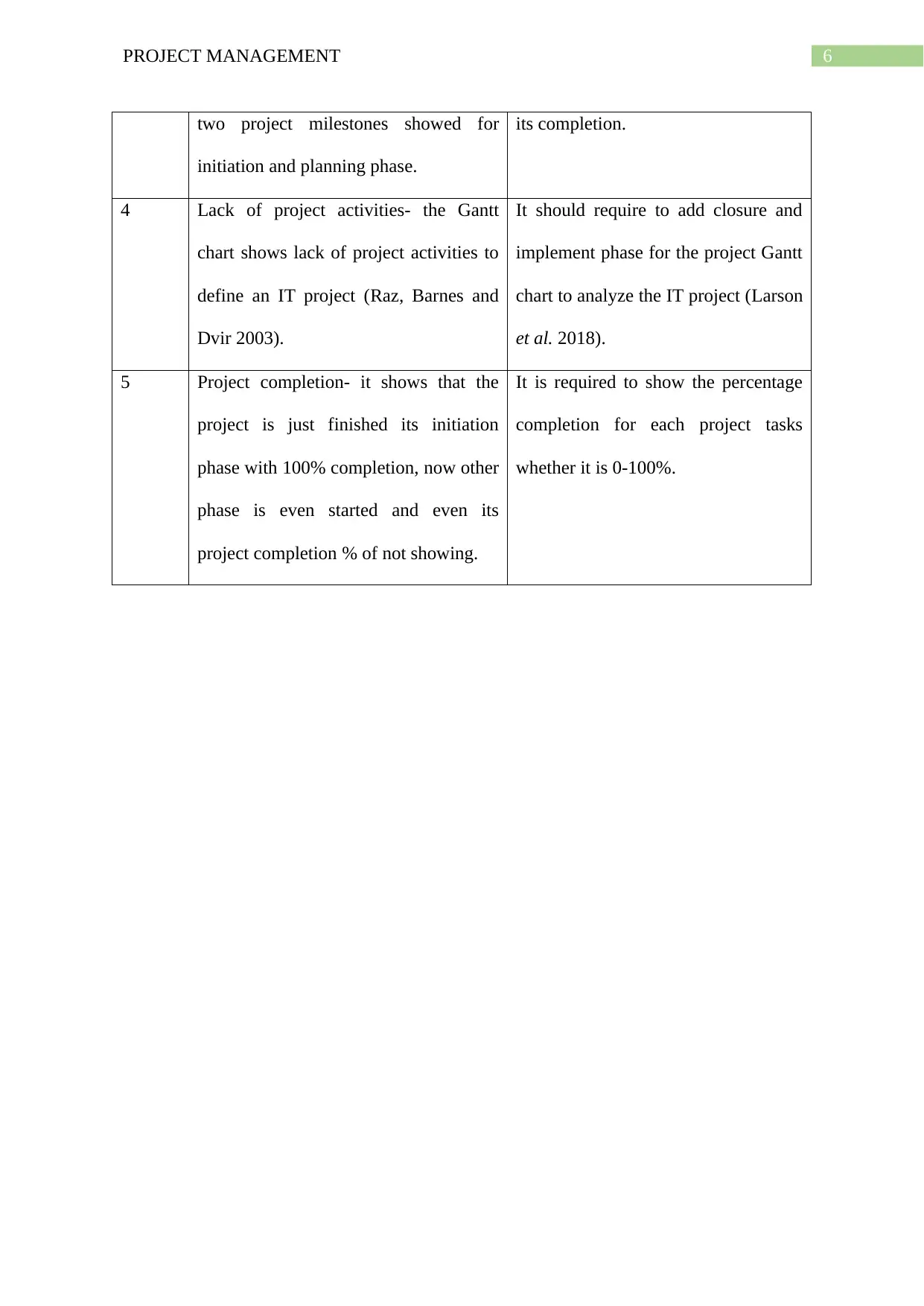
6PROJECT MANAGEMENT
two project milestones showed for
initiation and planning phase.
its completion.
4 Lack of project activities- the Gantt
chart shows lack of project activities to
define an IT project (Raz, Barnes and
Dvir 2003).
It should require to add closure and
implement phase for the project Gantt
chart to analyze the IT project (Larson
et al. 2018).
5 Project completion- it shows that the
project is just finished its initiation
phase with 100% completion, now other
phase is even started and even its
project completion % of not showing.
It is required to show the percentage
completion for each project tasks
whether it is 0-100%.
two project milestones showed for
initiation and planning phase.
its completion.
4 Lack of project activities- the Gantt
chart shows lack of project activities to
define an IT project (Raz, Barnes and
Dvir 2003).
It should require to add closure and
implement phase for the project Gantt
chart to analyze the IT project (Larson
et al. 2018).
5 Project completion- it shows that the
project is just finished its initiation
phase with 100% completion, now other
phase is even started and even its
project completion % of not showing.
It is required to show the percentage
completion for each project tasks
whether it is 0-100%.
Paraphrase This Document
Need a fresh take? Get an instant paraphrase of this document with our AI Paraphraser
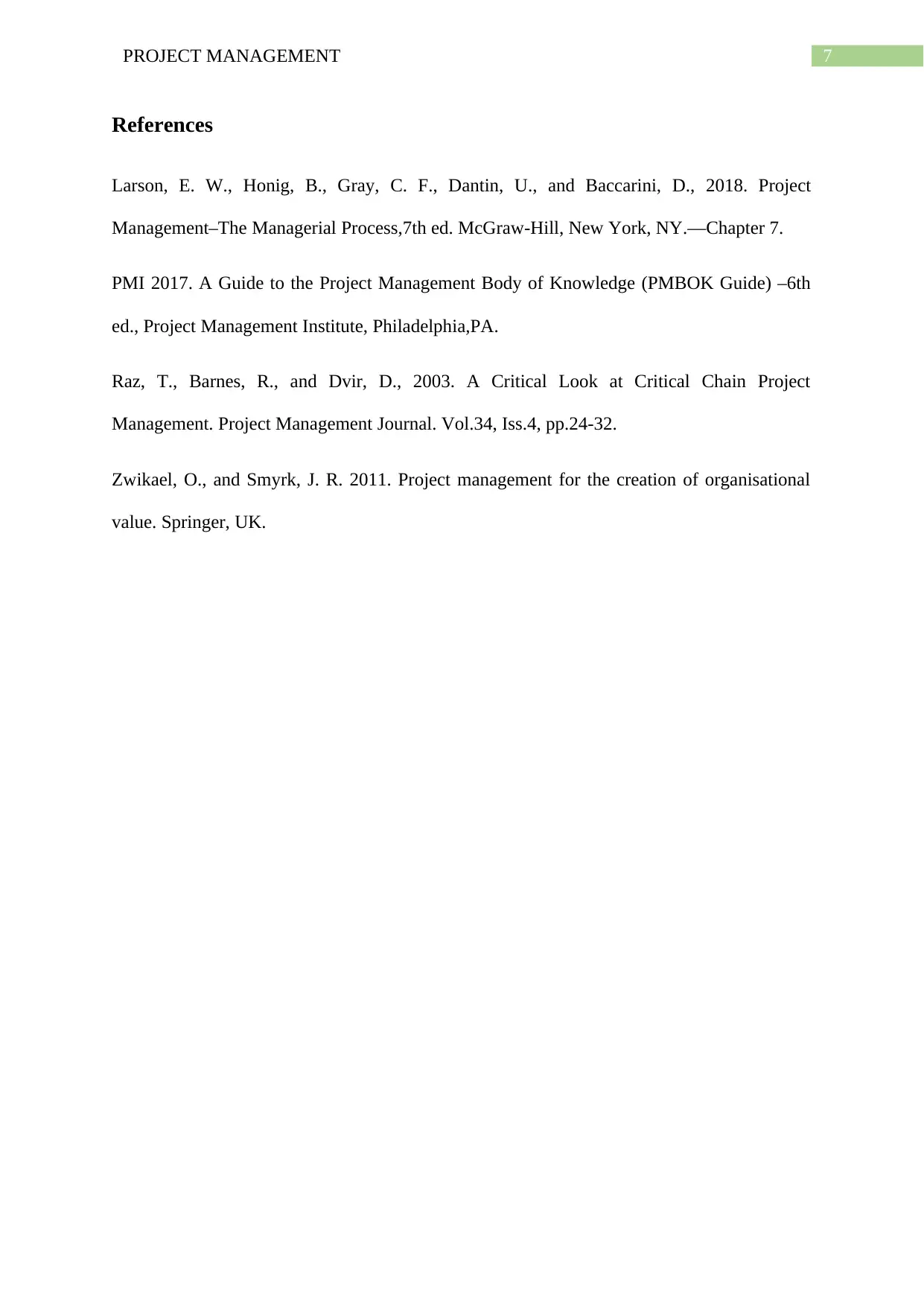
7PROJECT MANAGEMENT
References
Larson, E. W., Honig, B., Gray, C. F., Dantin, U., and Baccarini, D., 2018. Project
Management–The Managerial Process,7th ed. McGraw-Hill, New York, NY.―Chapter 7.
PMI 2017. A Guide to the Project Management Body of Knowledge (PMBOK Guide) –6th
ed., Project Management Institute, Philadelphia,PA.
Raz, T., Barnes, R., and Dvir, D., 2003. A Critical Look at Critical Chain Project
Management. Project Management Journal. Vol.34, Iss.4, pp.24-32.
Zwikael, O., and Smyrk, J. R. 2011. Project management for the creation of organisational
value. Springer, UK.
References
Larson, E. W., Honig, B., Gray, C. F., Dantin, U., and Baccarini, D., 2018. Project
Management–The Managerial Process,7th ed. McGraw-Hill, New York, NY.―Chapter 7.
PMI 2017. A Guide to the Project Management Body of Knowledge (PMBOK Guide) –6th
ed., Project Management Institute, Philadelphia,PA.
Raz, T., Barnes, R., and Dvir, D., 2003. A Critical Look at Critical Chain Project
Management. Project Management Journal. Vol.34, Iss.4, pp.24-32.
Zwikael, O., and Smyrk, J. R. 2011. Project management for the creation of organisational
value. Springer, UK.
1 out of 8
Related Documents
Your All-in-One AI-Powered Toolkit for Academic Success.
+13062052269
info@desklib.com
Available 24*7 on WhatsApp / Email
![[object Object]](/_next/static/media/star-bottom.7253800d.svg)
Unlock your academic potential
Copyright © 2020–2025 A2Z Services. All Rights Reserved. Developed and managed by ZUCOL.



